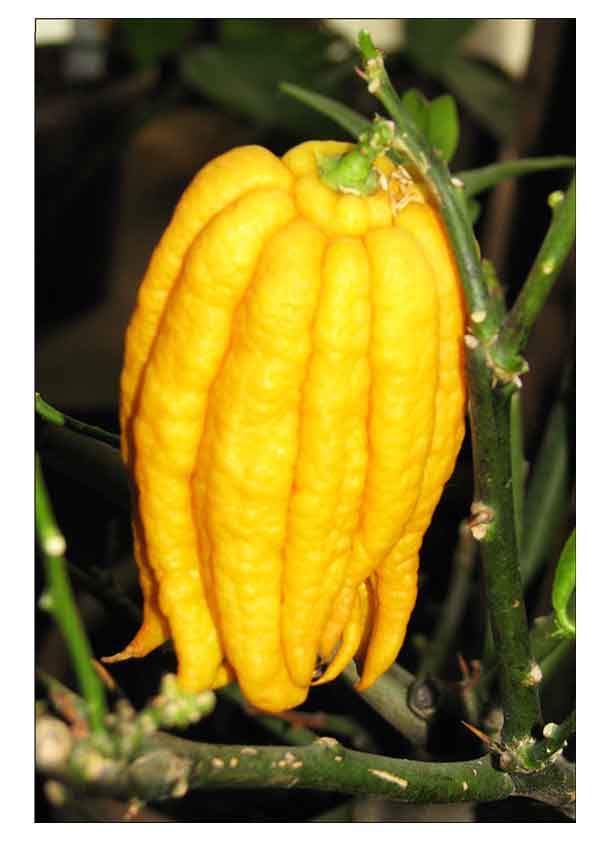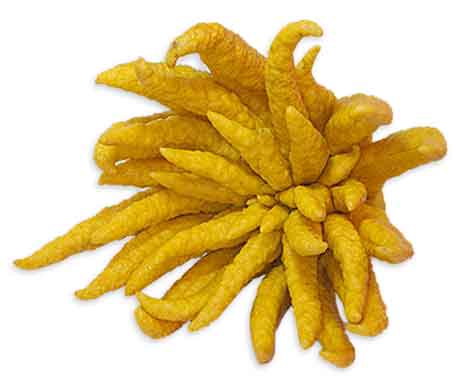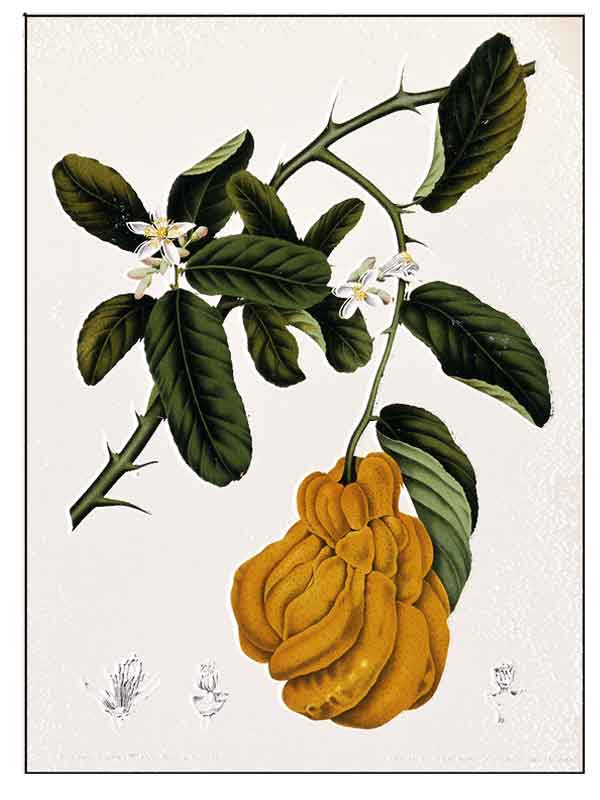 Gen info Gen info
- The citron is one of the original citrus fruits from which all other citrus types developed through natural hybrid speciation or artificial hybridization. Although cultivars take a wide variety of physical forms, they are all closely related genetically.
- Roots in antiquity: Citron has been cultivated since ancient times, predating other citrus species.
- Etymology: The fruit name Citron derives from Latin, citrus, which is the original origin of the genus name. The specific epithet medica means medicinal. The variety name sarcodactylis derives from Greek words sarkos meaing fleshy and dactylos meaning finger, in obvious referrence to the fruits.
- Citrus medica var. sarcodactylis or fingered citron is an unusually shaped citron variety whose fruit is segmented in finger-like sections, resembling those seen on representations of the Buddha; and hence, the name, Buddha's hands.
-
Different cultivars and variations of this citron variety ranged from "open-hand" types with outward-splayed segments to "close-hand" types with fingers kept together. There are half-fingered fruits, with the basal side united and the apical side fingered.
(2)
Botany
Citrus medica var. sarcodactylis is a shrub or small tree with long, irregular branches covered in thorns. Its large, oblong leaves are pale green and grow about four to six inches. Its white flowers are tinted purplish from the outside and grow in fragrant clusters. The fruit's fingers contain only the white part of the fruit and sometimes a small amount of acidic pulp, but many of them are completely juiceless and some are seedless.
(2)
 Citrus medica var. sarcodactylis is a shrub or small tree. Branches, leaf buds, and flower buds purplish when young. Branches with ca. 4 cm spines. Leaves simple or rarely 1-foliolate; petiole short, not winged; leaf blade elliptic to ovate-elliptic, 6-12 × 3-6 cm or larger, margin serrate, apex rounded, obtuse, or rarely mucronate. Inflorescences axillary, ca. 12-flowered or sometimes flowers solitary. Flowers bisexual or sometimes male by ± complete abortion of pistil. Petals 5, 1.5-2 cm. Stamens 30-50. Ovary cylindric; style long and thick; stigma clavate. Fruit pale yellow, elliptic to subglobose, to 2 kg, surface coarse; pericarp white to pale yellow and soft within, thicker than sarcocarp, removed with difficulty; sarcocarp with 10-15 segments, colorless, nearly pellucid to pale milky yellow, acidic to slightly sweet, fragrant. Seeds small; seed coat smooth; embryo(s) solitary to several; cotyledons milky white. (Flora of China) Citrus medica var. sarcodactylis is a shrub or small tree. Branches, leaf buds, and flower buds purplish when young. Branches with ca. 4 cm spines. Leaves simple or rarely 1-foliolate; petiole short, not winged; leaf blade elliptic to ovate-elliptic, 6-12 × 3-6 cm or larger, margin serrate, apex rounded, obtuse, or rarely mucronate. Inflorescences axillary, ca. 12-flowered or sometimes flowers solitary. Flowers bisexual or sometimes male by ± complete abortion of pistil. Petals 5, 1.5-2 cm. Stamens 30-50. Ovary cylindric; style long and thick; stigma clavate. Fruit pale yellow, elliptic to subglobose, to 2 kg, surface coarse; pericarp white to pale yellow and soft within, thicker than sarcocarp, removed with difficulty; sarcocarp with 10-15 segments, colorless, nearly pellucid to pale milky yellow, acidic to slightly sweet, fragrant. Seeds small; seed coat smooth; embryo(s) solitary to several; cotyledons milky white. (Flora of China)
Distribution
- Introduced, cultivated.
 Constituents Constituents
- Study of crude extract of fresh fruits isolated a new sesquiterpene compound, Citrumedin-C (1), along with 32 known compounds 5,7-dimethoxycoumarin (2), xanthyletin (3), oxypeucedanin hydrate (4), 6,7-dimethoxycoumarin (5), skimmin (6), haploperoside A (7), leptodactylone (8), 7-methoxycoumarin (9), scopoletin (10), cis-head-to-tail-limittin dimer (11), umbelliferone (12), nordentatin (13), limonin (14), nomilin (15), citrusin (16), obacunone (17), 3-(2-O-β-d-glucopyranosyl-4-methoxyphenyl)-propanoic acid (18), cis-p-coumaric acid (19), methyl vanillate (20), methyl benzoate (21), methyl paraben (22), 4-hydroxy-phenethyl alcohol (23), methyl-4-hydroxycinnamate (24), coniferin (25), syringin (26), (E)-6-hydroxy-2,6-dimethylocta-2,7-dienoic acid (27), a mixture of stigmasterol (28) and β-sitosterol (29), β-sitosteryl glucoside (30), chrysoeriol 8-C-glucoside (31), 1,2,3,4-tetrahydro-β-carboline-3-carboxylic acid (32), and citrylidene malonic acid (33). (see study below) (3)
- GC-MS study of oil from fruits yielded 21 components accounting for 98.51% of oil while leaves yielded 14 components accounting for 92.69% of total oil content. The major component for both flowers and leaves is limonene representing 60.31% and 32.11% respectively. (see study below) (6)
- Study of fruit essential oil yielded major compounds (% in EO): d-limonene (51.24), γ-terpenene (33.71), α-pinene (3.40), and β-pinene (2.88). (see study below) (7)
- Phytochemical studies on fruits have isolated polysaccharides, neolignans, flavonoids, coumarins, terpenoids, glycosides, etc.
- GC-MS study of fruit peel and pulp for volatile compounds yielded 56 hydrocarbons, 33 alcohol compounds, 11 aldehyde compounds, 11 ester compounds,
10 ketones compounds, 6 acid compounds, 5 phenol compounds, 5 furans compounds, 3 bases compounds, amide, halogen, lactone, nitrile, oxide and 9 other compounds. In comparison, the peel was richer in volatile compounds. (14)
- GC-MS study of fruit peel from two different chemotypes identified 40 compounds accounting for almost 99% of the oils. The major oil constituent of one chemotype was limonene (48.4%) and p-cymene (33.7%), while the other chemotype yielded predominantly limonene (55.5%) and
γ-terpinene (22.5%). (16)
Properties
- Studies have suggested antioxidant, hypolipidemic, immunosuppressive, antimicrobiial, antiviral, autonomic nervous system stimulant, gastroprotective properties.
Parts used
Fruits, leaves.
Uses
Edibility
- The fruit does not contain much flesh or juice. Underneath the rind, there is a seedless edible white tissue. Avoid the pith as it is quite bitter. The peel is usable, although not eaten, but used to infuse aroma and fragrance for cooking and baking dishes. Fruit fingers can be candied and zests used as garnish in drinks, teas, cordials, as ingredients in vinagrettes or marmalades, and as flavoring for preserves, biscotti, and desserts. (13)
Folkloric
- No reported folkloric medicinal use in the Philippines.
- In Chinese traditional medicine, used for harmonizing the stomach and expelling phlegm, and used as adjuvant herbal medicine for hypertension, tracheitis, respiratory tract infections, angiocardiopathy and asthma. (•) Used for regulating qi, treat liver and stomach qi stagnation, chest and flank pain.
- Used as a tonic, antispasmodic.
Others
- Rituals: Fruits are used as temple offerings in the Buddhist religion, hence, the common name Buddha's hand, especially one with close fingers resembling a hand closed in prayer. Symbolizing happiness, long life, and good fortune, it is a popular New Year's fruit gift in Japan.
- Scent: Peels used as natural air freshener; also, as fragrance in cosmetics.
Studies
• Inhibition of Superoxide Anion Generation and Elastase Release / Fruits: Study of crude extract of fresh fruits isolated a new sesquiterpene compound, Citrumedin-C (1), along with 32 known compounds. Only 6,7-dimethoxycoumarin (3)(5) exhibited significant inhibition of superoxide anion generation, with IC50 of 3.8 ± 1.4 µM. ( see constituents above) (3)
• Hypolipidemic / Immunosuppressive / Biflavonoids from Fruits: Study of fruits yielded six new (3'--> 7")-biflavonoids (1-6) and 12 known biflavonoid derivatives (7-18). Compounds (1-18) were evaluated for hypolipidemic activities with Orlistat as positive control, and assayed for immunosuppressive activities with Dexamethasone as control. Compounds 1-3 exhibited moderate inhibition of pancreatic lipase activities with % inhibition of 68.56%, 56.18%, 53.51% at concentration of 100µM, respectively. Compounds 4-6 and 8 showed potent immunosuppressive activities with IC50s of 16.83 to 50.90 µM.(4)
• Essential Oil / Antioxidant / Variation during Maturation Stages / Fruits: Study evaluated the variations of essential oil (EO) yield, composition, and antioxidant activities during three maturation stages in finger citron (FC) fruits. EOs yielded showed marked increase during maturation process. GC-MS study identified 27, 22, and 22 components in immature, intermediate, and mature stages, representing 99.56%, 99.38% and 99.54% of total detected constituents, respectively. Limonene, the main component, varied between 32.07% and 36.37%, and was statistically significant during maturation stages. Components viz. α-thujone, 3-carene, α-pinene and α-terpinene varied significantly during maturation stages. Antioxidant activity decreased during maturation process. Maturity influenced both quality and quantity of essential oils. (5)
• Antimicrobial / Antiviral / Essential / Fruits and Leaves: GC-MS study of oil from fruits yielded 21 components accounting for 98.51% of oil while leaves yielded 14 components accounting for 92.69% of total oil content. The major component for both flowers and leaves is limonene representing 60.31% and 32.11% respectively. Fruit derived oil exhibited more potent antimicrobial activity than leaves. Fruit oil showed moderate antifungal activity against Aspergillus niger. Leaf oil at concentration of 0.5 µg/µl showed antiviral activity against avian influenza A H5N1 virus. (6)
• Insulin Secretagogue Effect / Antiviral / Essential / Fruits and Leaves: Study evaluated invivo safety, hypoglycemmic and antidiabetic effects in Sprague-Dawley rats and Wistar rats. Kinetic analysis on hypoglycemic patterns of intraperitoneal glucose tolerance (IPGTT) and insulin-glucose tolerance tests (IGTT) confirmed the insulin secretagogue effect. Results suggest fruits possess insulin secretagogue and slimming effects that could be very beneficial for type 2 diabetes patients. (see constituents above) (7)
• Galactorhamnan Polysaccharide / Anti-Inflammatory: Study isolated a new polysaccharide,
K-CMLP, from C. medica var. sarcodactylis fruits. The K-CLMP consisted of rhamnose, galactose, and glucose. Both CMLP and K-CMLP exhibited strong free radical scavenging properties in a dose-dependent manner. K-CMLP significantly inhibited the production of pro-inflammatory cytokines (IL-6 and TNF-α) and reactive oxygen species (ROS) in RAW 264.7 cells treated with LPS. (8)
• Stimulant / Effect on the Autonomic Nervous System / Peel: Study evaluated the chemical composition of peel oil and its effect on the autonomic nervous system (blood pressure, hear rate, skin temperature, and respiratory rate) and mood responses after inhaling. Major components of the EO were limonene (65.11%) and gamma terpinene (34.89%). Results showed fingered citron oil caused significant increase in blood pressure and respiratory rate upon exposure to inhaled oil via inhaler. It also increased positive emotions like well-being, activeness, and freshness and significantly reduced negative emotions such as drowsiness. (9)
• Gastroprotective / Ethanol Induced Gastric Mucosal Injury / Fruits: Study evaluated the gastroprotective effect on ethanol-induced gastric mucosal injuries in rats comparing CSF (fruit) and dried and steam processed fruits CSF (SCSF). GC-MS study yielded 42 components in CSF and SCSF, mostly flavonoids, limonoids, coumarins, and glycosides, with no differences in composition, although relative contents of components were different. Pretreatment with CSF and SCSF markedly improved the gastric mucosal injuries. The SCSF exhibited better gastroprotective effect, which emphasized the benefits of steam processing. Effects were attributed to enhancement of antioxidant and anti-inflammatory activities. (11)
• Antimicrobial / Fruit Peel Essential Oil: Study evaluated the antimicrobial effect of essential oils of fruit peel oil on pathogenic bacteria. Hydrodistillation of hand fruit peels yielded 0.75% (7.5 g/1 kg) of fresh peel. The EO of fruit peel showed effective antibacterial activities on test isolates with zones of inhibition of 18 mm for Enterobacter cloacae, 15 mm for Escherichia coli and Pseudomonas aeruginosa, 22 mm for Klebsiella pneumonia, 20 mm for Proteus mirabilis, Bacillus sp., and Streptococcus spp., 25 mm for Staphylococcus aureus. Results suggest potential as therapeutic agent against human microbial infections. (12)
• Immunoregulatory / Antioxidant / Polysaccharide: Study purified a new homogenous heteropolysaccharide (CMSPA90-1), which consisted of a pyranoside and funanside. CMSPA90-1 exhibited free radical scavenging activity by DPPH and ABTS assays. CMSPA90-1 could promote proliferation of mouse splenocytes and neutral red phagocytosis of RAW264.7 cells, which suggested potential for development of functional foods or natural medicines. (15)
• Immunoregulatory / Antioxidant / Polysaccharide: Study evaluated the effect of a nanoemulsion of essential oil on antioxidant, antibacterial, and antibiofilm activity. GC-MS analysis yielded 19 compounds in the EO, dominated by d-limonene (50.04%). Hydroxyl radicals, DPPH radical scavenging ability, iron reducing power, antibacterial, and antibiofilm activity of the nanoemulsified EO were significantly higher than those of pure EO at the same concentration. (17)
Availability
Cultivated.
|

![]()



 Gen info
Gen info
 Constituents
Constituents